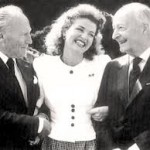By Rebecca Schmid
The Berlin Philharmonic is celebrating the centenary of Lutosławski with several concerts this month. The first of the series on February 7—featuring his Concert for Orchestra—opened appropriately with Anne-Sophie Mutter, who premiered one of his most important works, Chain Two, in 1988. In an interview I conducted two years ago, the violinist recalled how seeing the score triggered a passion for contemporary music which she continues to nurture. Her appearance at the Philharmonie alongside guest conductor Manfred Honeck took an unrelated historic twist with a performance of Dvořák’s Romance in F-minor, although the Czech composer’s innovative integration of folk music can be seen to have foreshadowed composers such as Bartok and Lutosławski. The last violinist to perform this work with the Philharmonic is Carl Flesch, in 1909. As Mutter also explained to me, she considers herself a kind of ‘great-grandchild’ of the legendary violinist given that Flesch taught her mentor Aida Stücki.
The Romance is derived from the slow movement of Dvořák’s String Quartet in F-minor, with a main melody so melting one understands why the composer was tempted to repurpose it. He gives it a short fugal exposition in the orchestra before the violin enters, wrought well by the transparent timbre of the Philharmonic’s strings, although the sound was tense during later fortissimo passages. Mutter brings a crying quality to her high notes which pushed the Romantic emotion to the edge, and struck a mix of strength and fragility in the cantabile lines, yet the tempo was slightly pressed. The pacing was more solid for Dvořák’s Violin Concerto, and the orchestra warmed up to a more communal sound in tutti episodes. Honeck’s conducting remained deferential, if not slightly meek, but clear. Mutter and the orchestra gave the fast opening movement a glowing but icy sheen, while the inner Adagio swooned with more sentimentality. The final Allegro giocoso was the most exciting. Mutter carved out melodies with the sweet but slick tone that has inspired composers from Rihm to Penderecki, and Honeck brought out the folksy rhythms with natural flair.
Folklore plays an equally important role in Lutosławski’s Concert for Orchestra, which effectively established him as a generation’s leading composer in 1950s Poland. Its rigorous yet experimental development of tonality and rich orchestration certainly qualify it as a modernist masterpiece that deserves to be heard more often in concert halls. The instrumentation of his Concert is full of delicious subtlety, such as a piccolo solo that moves through a dissolving circle of fifths above swirling winds and strings in the inner Capriccio. But it is the final Passacaglia, Toccata e Corale that, for this listener, captures Lutosławski’s genius, with a bass line that is passed through monumental brass to the middle of the orchestra before the outer voices come crashing against it. The violins are left with the melody, a remnant of a culture that once was, against a jarring piano chord as the rest of the orchestra dies. Once the music comes back to life, the counterpoint locks into clockwork before dismantling like a cubist painting (I thought of the Czech artist Bohumil Kubista, a member of the New Secession movement), with dark, atmospheric colors that overcome angst with their own sense of order. Honeck led the work with spirit and spontaneity, and the Philharmonic responded with smooth precision.
Tags: Anne-Sophie Mutter, Antonin Dvorak, Berlin Philharmonic, Bohumil Kubista, Carl Flesch, Chain Two, Manfred Honeck, Penderecki, Rebecca Schmid, Rihm, Witold Lutoslawski
